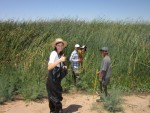Over the years, researchers at the Central Arizona-Phoenix (CAP) Long Term Ecological Research (LTER) program have noticed that student research teams mentored by experienced graduate students and faculty provide a rich environment for engaging in urban social-ecological research and learning. Two CAP initiatives provide examples of how student teams are involved in urban ecosystems field and lab work.
The Tres Rios project
The Tres Rios wetlands, constructed by the City of Phoenix as an alternative to traditional wastewater treatment, are a living laboratory for students in the Wetland Ecosystem Ecology Lab. Led by CAP co-PI Dan Childers, this research team investigates how the constructed wetlands treat wastewater in an arid environment by understanding the function of wetland plants and soils, and nutrient and water budgets.
High school, undergraduate, and graduate students have been conducting field work at Tres Rios, as well as laboratory analyses, for four years. For the high school students, this is their first opportunity to do real hands-on research, but university students also relish the opportunity to engage in field work in a designed “working” ecosystem. Student research findings have been communicated in several research posters, presentations, and journal articles in review. The team also has regular “research charrettes” in City Hall to communicate their research results to the City of Phoenix. This partnership is helping to inform better management of the wetlands.
Heat in the desert
Extreme heat is a critical public health concern in the Valley of the Sun and is expected to become more of a problem under climate change projections. CAP researchers David Hondula and Evan Kuras are leading an effort to develop new understandings of how urban heat affects people through the measurement of individually experienced temperatures (IETs). Recently, the two initiated a student team research effort to measure IETs in the Phoenix area, building on Kuras’ prior work in Boston. Students participated as part of a research-for-credit experience supervised by Hondula.
During summer and fall 2015, the team of Kuras, Hondula, and eight undergraduate researchers recruited people in five Phoenix neighborhoods to measure and record their IETs. Students interviewed the participants and equipped them with Thermochron iButtons to measure IETs at five minute intervals over the course of one week. After analyzing their data and preparing research papers, the student teams reported their preliminary results during the CAP LTER All Scientists Meeting in January 2015. A few of the students have built on this research as part of their honors theses and capstone projects. An evaluation of the students’ experience found that students enhanced their research skills considerably and gained an appreciation for the time and work needed to be a research scientist. Continued efforts in partnership with Arizona State University’s Center for Policy Informatics are exploring how individual level data regarding heat exposure can be communicated to citizens and policymakers to reduce health dangers associated with hot weather.

 Enlarge this image
Enlarge this image
